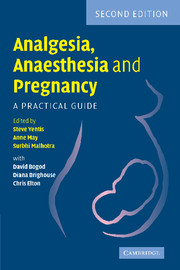Book contents
- Frontmatter
- Contents
- List of contributors
- Preface
- SECTION 1 PRECONCEPTION AND CONCEPTION
- SECTION 2 PREGNANCY
- I Procedures in early/mid-pregnancy
- II Normal pregnancy and delivery
- III Operative delivery and third stage
- IV Anaesthetic complications
- V Problems confined to obstetrics
- VI Problems not confined to obstetrics
- VII The neonate
- SECTION 3 PUERPERIUM AND AFTER
- SECTION 4 ORGANISATIONAL ASPECTS
- Index
VI - Problems not confined to obstetrics
Published online by Cambridge University Press: 10 November 2010
- Frontmatter
- Contents
- List of contributors
- Preface
- SECTION 1 PRECONCEPTION AND CONCEPTION
- SECTION 2 PREGNANCY
- I Procedures in early/mid-pregnancy
- II Normal pregnancy and delivery
- III Operative delivery and third stage
- IV Anaesthetic complications
- V Problems confined to obstetrics
- VI Problems not confined to obstetrics
- VII The neonate
- SECTION 3 PUERPERIUM AND AFTER
- SECTION 4 ORGANISATIONAL ASPECTS
- Index
Summary
ALLERGIC REACTIONS
Patients may be mildly allergic to many substances and this may become better or worse during pregnancy. Severe reactions, however, are rare on the labour ward. Most severe reactions are either anaphylactic or anaphylactoid. Anaphylactic reactions involve release of histamine and other inflammatory mediators from mast cells via cross-linkage of IgE molecules on the cell surface by the antigen molecule; this process requires prior exposure to the antigen. Anaphylactoid reactions involve direct release of mediators from mast cells via interaction of molecules (e.g. drugs) with the cell surface in a different way; this does not require prior exposure. The difference is largely academic since the clinical presentation is identical. Less commonly, direct complement activation may be involved.
Most severe reactions on the labour ward are caused by drugs, especially antibiotics, intravenous anaesthetic drugs (particularly suxamethonium) and oxytocin. Some well-recognised cross-reactions exist, e.g. up to 10% of individuals with true penicillin allergy are also allergic to cephalosporins. Allergy to amide local anaesthetic drugs is rare but has been reported, as has allergy to preservatives used in local anaesthetic and other drug preparations. Non-steroidal antiinflammatory drugs and paracetamol often cause rashes but these are usually mild following brief oral/rectal courses, although severe reactions have been reported following intravenous administration. Reactions may also follow administration of gelatine intravenous fluids and blood. Latex allergy has become an increasing problem amongst both medical staff and patients, driven by an increase in the wearing of gloves because of concern about transmission of blood-borne infection and the ubiquitous use of latex in home and work environments.
- Type
- Chapter
- Information
- Analgesia, Anaesthesia and PregnancyA Practical Guide, pp. 204 - 325Publisher: Cambridge University PressPrint publication year: 2007

